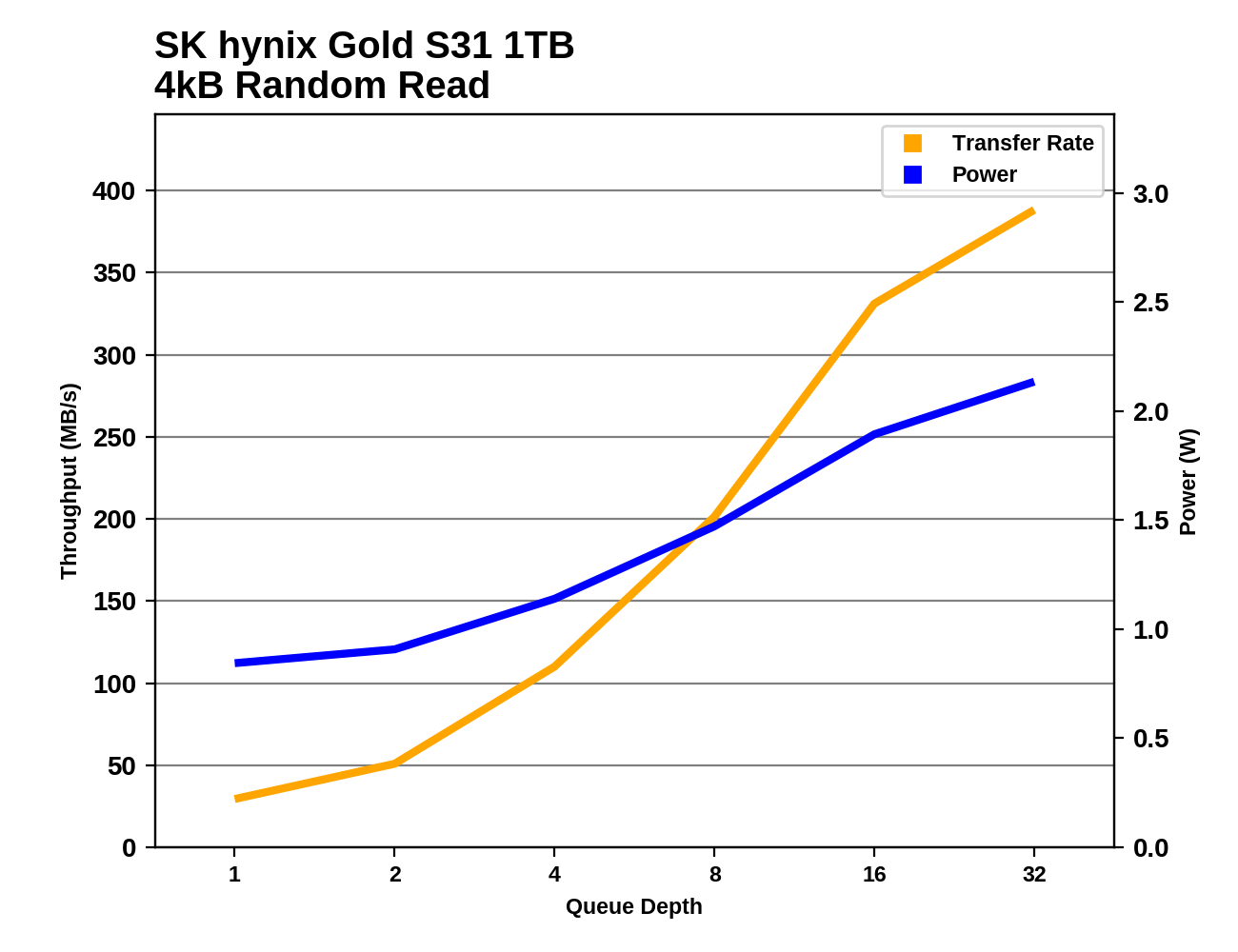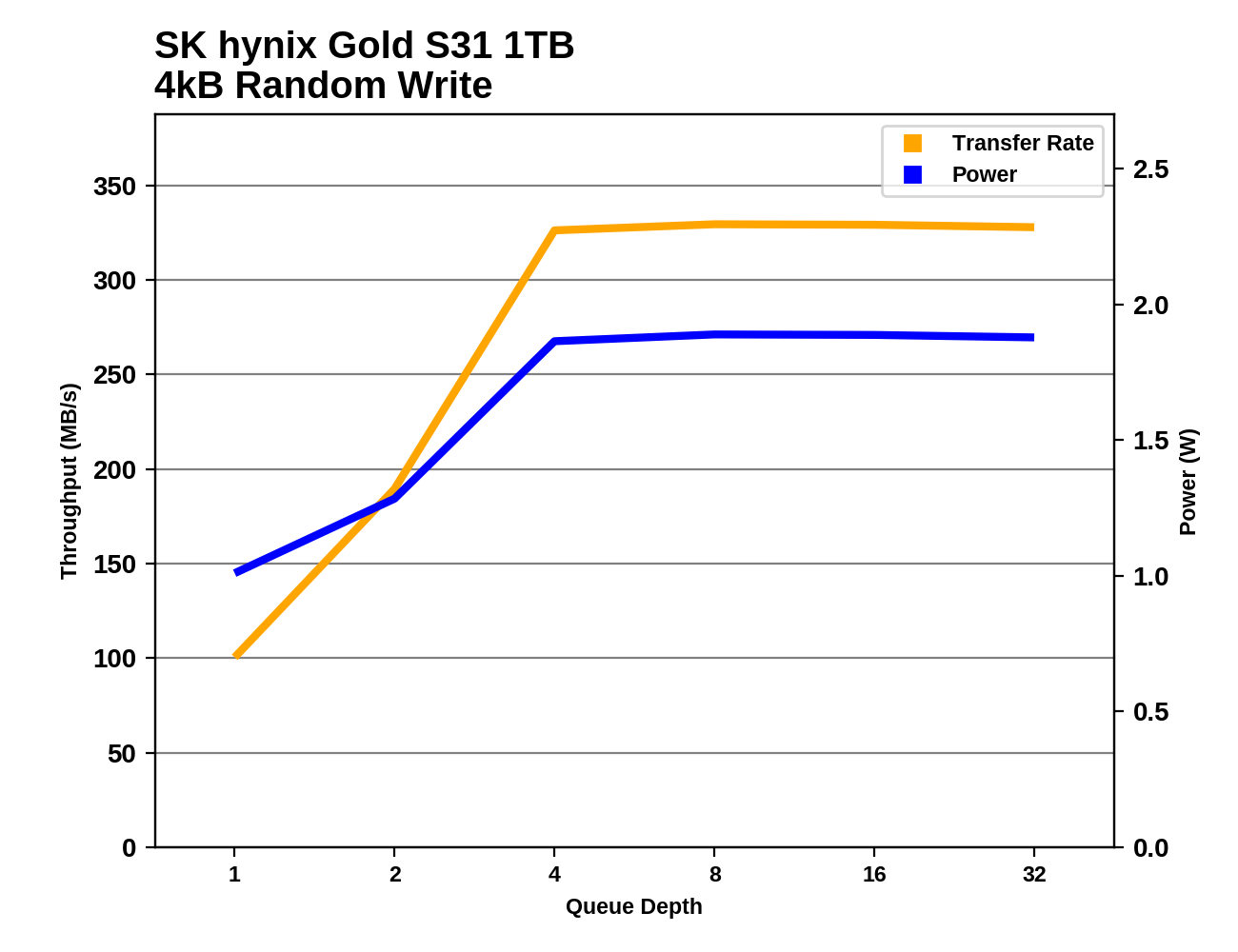The SK Hynix Gold S31 SATA SSD Review: Hynix 3D NAND Finally Shows Up
by Billy Tallis on November 13, 2019 12:00 PM ESTRandom Read Performance
Our first test of random read performance uses very short bursts of operations issued one at a time with no queuing. The drives are given enough idle time between bursts to yield an overall duty cycle of 20%, so thermal throttling is impossible. Each burst consists of a total of 32MB of 4kB random reads, from a 16GB span of the disk. The total data read is 1GB.

The burst random read performance of the SK Hynix Gold S31 isn't great: it's more in line with what we see from DRAMless SSDs than from most recent mainstream TLC-based drives.
Our sustained random read performance is similar to the random read test from our 2015 test suite: queue depths from 1 to 32 are tested, and the average performance and power efficiency across QD1, QD2 and QD4 are reported as the primary scores. Each queue depth is tested for one minute or 32GB of data transferred, whichever is shorter. After each queue depth is tested, the drive is given up to one minute to cool off so that the higher queue depths are unlikely to be affected by accumulated heat build-up. The individual read operations are again 4kB, and cover a 64GB span of the drive.

On the longer random read test, the S31s are clearly ahead of the DRAMless and QLC drives, but still a bit slower than typical for a mainstream SATA drive.
 |
|||||||||
| Power Efficiency in MB/s/W | Average Power in W | ||||||||
The SK Hynix Gold S31s all provide excellent power efficiency during the random read test; they draw only slightly more power than the DRAMless Toshiba TR200, and much less power than any of the mainstream SATA SSDs in this comparison. The MLC-based Samsung 860 PRO is the only drive in this batch that delivers a better performance per Watt ratio, which it achieves by being about 30% faster than the TLC drives while consuming similar amounts of power.
 |
|||||||||
The 250GB S31's random read performance starts to fall behind the 1TB model with queue depths higher than about 4, while the 500GB more or less keeps pace through QD8. Compared to competing mainstream TLC drives from Samsung, Crucial and WD/SanDisk, the 1TB S31's performance never falls far behind, but its power consumption is almost always lower, often by a significant amount.
Plotting the S31's performance and power usage during the random read test against all the other SATA drives we've tested reveals that the S31 doesn't quite break the power efficiency record, but it comes pretty close except at the highest queue depths.
Random Write Performance
Our test of random write burst performance is structured similarly to the random read burst test, but each burst is only 4MB and the total test length is 128MB. The 4kB random write operations are distributed over a 16GB span of the drive, and the operations are issued one at a time with no queuing.

As with random reads, the burst random write performance of the SK Hynix Gold S31 is a bit slower than the competition, but this time the deficit is definitely smaller.
As with the sustained random read test, our sustained 4kB random write test runs for up to one minute or 32GB per queue depth, covering a 64GB span of the drive and giving the drive up to 1 minute of idle time between queue depths to allow for write caches to be flushed and for the drive to cool down.

On the longer random write test, the 500GB and 1TB models of the S31 perform similarly and are competitive with everything but the Samsung drives. The 250GB model is 25% slower than the 500GB, which still leaves it substantially faster than the DRAMless or QLC-based drives.
 |
|||||||||
| Power Efficiency in MB/s/W | Average Power in W | ||||||||
The S31 again uses less power than other mainstream SATA drives, and that allows the larger two models to turn in efficiency scores that are second only to Samsung's high-end options. The slower 250GB model's efficiency score is comparable to some of the better 500GB and 1TB competitors.
 |
|||||||||
The 1TB and 500GB S31s hit full random write speed at QD4, and maintain that performance through the rest of the test without any trouble. The 250GB model saturates a bit earlier and even at QD2 is pretty close to its maximum random write throughput, but at least it too is steady and well-behaved for the rest of the test.
Plotting the results against the entire archive of SATA tests, the 1TB S31 again isn't setting any new efficiency record, but it is definitely one of the most power-efficient SATA drives for a random write workload.












22 Comments
View All Comments
bananaforscale - Sunday, November 17, 2019 - link
And PLC will probably suck even more than QLC.netzflickzz - Friday, October 2, 2020 - link
On the off chance that you are intending to switch the versatile organization, at that point it is the correct opportunity to https://netflicsaccounthack.club/ go for somebody who pays for your Netflix account. T-Mobile has dispatched an arrangement where you can utilize their administrations while profiting Netflix represent free or for an insignificant charge.Charlie22911 - Wednesday, November 13, 2019 - link
How about we get some capacity bumps while we are at it too! I’d love to toss a 4TB QLC m.2 SSD in my laptop, one less thing to carry like the portable rust for my extensive Steam library.eek2121 - Wednesday, November 13, 2019 - link
Your laptop likely has a 2.5" sata bay. I expect we shot ourselves in the foot with m.2. There is quite a bit less space for the nand and controller, and m.2 drives are harder to cool. I personally had to buy a heatsink for my 970 evo.kpb321 - Wednesday, November 13, 2019 - link
At 4tb your drive cost is going to have pretty much linear scaling with the size as the cost of the NAND becomes the dominating factor which is what we see in the pricing chart even for 2.5' drives where space shouldn't be an issue. The 250 gb drives have a higher cost per gb reflecting the costs for the enclosure, the controller and dram, and circuit board. By 512gb or 1tb the cost per gb has become flat. A 4tb M2 drive would be a little bit harder to do than a 2.5' drive but I still think the main limitation is the relatively limited market for 400-500 SSD drives and currently 2.5' drives address more of that market.Death666Angel - Thursday, November 14, 2019 - link
Don't confuse M.2, NVME and SATA. There's a difference between protocoll and form factor. And I have no cooling on 2 out of 3 of my desktop M.2 NVME drives, just normal case ventilation for an upper midrange build, and they are fine around 40 to 50°C idle and never above 60°C when doing things (copy, extract, compress). What sort of situation led to your Evo throttling?firewrath9 - Saturday, November 16, 2019 - link
You can fit the exact same controller, nand, and dram on M.2 ssd as you can in a 2.5" one.Have seen the PCB on any recent SSD, 2.5" or M.2?
Besides, I'd rather have a larger battery, lighter/smaller laptop, or better cooling system or a combination of those than a 2.5" bay.
milli - Thursday, November 14, 2019 - link
Always loved the Corsair Neutron. While not giving peak performance, it gave very stable performance. It seems that this legacy is still existing with this controller.jabber - Thursday, November 14, 2019 - link
I see the moaning comments re. these drives, stagnation, low speeds etc.Then I get handed a customers laptop which still has a 500GB spinner in it and I remember how far from reality some of us have come. You've never had it so good!MenhirMike - Thursday, November 14, 2019 - link
True, but "You've never had it so good!" has been true for decades. That 500 GB spinner is so much better than a 40 GB spinner from a few years before, and despite that 500 GB spinner being the "never had it so good" of its time, we got bigger, faster, cheaper drives.That doesn't mean we should just be happy with what we've got and stop asking for more :) I want to see 5c/GB as soon as possible, 2 TB/$100 drive, and maybe some 4 TB/$200 drive would be welcome.